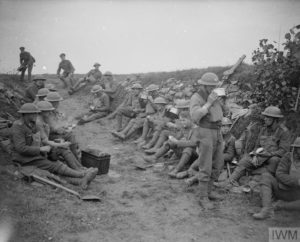Wednesday August 28th, 1918
Second day light duty. Raining hard. Nothing to do.
Platoon as ‘Unit of Assault’

The Battalion has now completed its Programme of Work and Training for August, but continues to work on completing the Bombing Course. Over the past couple of weeks it has been honing its combat skills.
Infantry tactics changed significantly over the course of WWI. One major change was made in 1917 when it was decided that the Platoon, comprising ~40 men, would be the ‘Unit of Assault’ rather than the 1,000 strong Battalion. Consequently the Platoon was reorganized to accommodate ‘all the weapons with which the Infantry are now armed‘.
The photograph shows one such unit of assault. They are the troops of Number 1 Platoon, A Company, 10th Battalion of the Duke of Cornwall’s Light Infantry Regiment. They are breakfasting on their way to the line near Le Quesnoy, October 27th, 1918.^
A pamphlet ‘Instructions for the Training of Platoons for Offensive Action, 1917’ was issued by the General Staff. It was written to help the Platoon Commanders ‘in training and fighting their platoons‘.¹
Organizing the Platoon
A Battalion, ~800 men, was typically divided into four companies and each company divided into four platoons. The platoon, excluding HQ staff, had a minimum strength of 28 and a maximum of 44 other ranks (OR). It was typically under the command of a Lieutenant or Second Lieutenant.
Assuming a typical strength of 36 OR plus four HQ staff including the officer, its organization was recommended to comprise four sections covering Bombers, Lewis Gunners, Riflemen and Rifle Bombers. Each section was made up of one NCO and eight OR. ²
Training the Platoon
Over the past few days, training across the 9th Battalion has been broadly focused. It has included route marching, bayonet work with and without gas masks, and musketry. Specialist classes have also been undertaken in scouting, Lewis Guns and signalling. Similarly officers and NCO receive additional instruction.
The 9th is being prepared for combat.
9th Battalion / Manchester Regiment War Diary – 28 August 1918 – Haudricourt
Bn working to finish Bombing Course. Officers & NCOs Outpost scheme on the ground. Conference at Brigade HQ for young officers. 2Lt CF Groves returned from leave to UK.
References & Further Reading
¹ & ² ‘Instructions for the Training of Platoons for Offensive Action, 1917’ as reproduced in Chapter 10 of ‘An Officer’s Manual of the Western Front: 1914-18’ by Stephen Bull, Conway, 2014.
^ Q 7154, copyright Imperial War Museums


